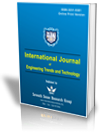Spatial Adaptation in Simple Housing: A Case Study of Changes in Size, Type, and Layout of Space in the Moncongloe Area, Maros
Spatial Adaptation in Simple Housing: A Case Study of Changes in Size, Type, and Layout of Space in the Moncongloe Area, Maros |
||
 |
 |
|
| © 2025 by IJETT Journal | ||
| Volume-73 Issue-4 |
||
| Year of Publication : 2025 | ||
| Author : Marwati, Baharuddin Hamzah, Nasruddin, Hartawan |
||
| DOI : 10.14445/22315381/IJETT-V73I4P126 | ||
How to Cite?
Marwati, Baharuddin Hamzah, Nasruddin, Hartawan, "Spatial Adaptation in Simple Housing: A Case Study of Changes in Size, Type, and Layout of Space in the Moncongloe Area, Maros ," International Journal of Engineering Trends and Technology, vol. 73, no. 4, pp.301-321, 2025. Crossref, https://doi.org/10.14445/22315381/IJETT-V73I4P126
Abstract
The subsidized modest housing program helps lower-middle-income families own their own homes. Subsidized houses are built simultaneously in the buffer areas of Makassar City, including Moncongloe, Maros, and Indonesia. The main houses undergo significant spatial changes in less than five years from construction, despite regulations that require maintaining the original structure for the first five years of occupancy. This research examines changes in these houses' function and spatial layout, focusing on aspects of function, location, and space. The sample is selected purposefully based on changes that still reflect the original shape of the house and the occupants' willingness to participate. Data is analyzed descriptively, categorizing changes according to space area, space function, methods of modification, and the location of spaces on the site. The results show that changes occur in the front and back areas of the house, with the addition of functional spaces such as a business area (kiosk), dining room, and family room. Space expansion is evident in the living room and kitchen, while the bedroom and bathroom remain relatively stable. The front zone of the house (terrace and garden) is frequently converted into a living room or business area. This study provides insight into how modest homes are functionally modified to meet occupants' needs and offers guidance for designers and policymakers in developing more sustainable and comfortable housing.
Keywords
Simple Housing, Post-Occupancy Modifications, Design Flexibility, Space Needs, Moncongloe.
References
[1] Tommy K. Rony, Subsidized Housing Program Continues, Developers Request This, Liputan6.com, 2019. [Online]. Available: https://www.liputan6.com/bisnis/read/4101938/program-rumah-subsidi-berlanjut-ini-permintaan-pengembang/
[2] Amri Nur Rahmat, A Thousand Subsidized Houses Built in South Sulawesi,” Bisnis.com, 2017. [Online]. Available: https://ekonomi.bisnis.com/read/20170923/48/692304/seribu-rumah-subsidi-dibangun-di-sulawesi-selatan?utm_source=desktop&utm_medium=search/
[3] Heri Murniati, “Subsidy KPR-RSH in Bumi Sudiang Permai Housing, Makassar,” Doctoral Thesis, Diponegoro University, pp. 1-166, 2010.
[Google Scholar]
[4] Erni Murniarti, and Wellem Sairwona, “Learning Management System Urgent Needs in Supporting Digitalization and Accreditation of Higher Education Institutions of Indonesian Christian University,” Digitalization and Internationalization towards Excellent APT and Great UKI 67th Anniversary of the Indonesian Christian University, Jakarta, pp. 269-279, 2020.
[Google Scholar] [Publisher Link]
[5] M. Syamsuddin, “Evaluation of Resident Satisfaction Levels towards Environmental Facilities at BTP Makassar Housing,” Hasanuddin University, 2000.
[Google Scholar]
[6] Decree of the Minister of Public Works and Public Housing Number 242/KPTS/M/2020, Decree of the Minister of Public Works and Public Housing. Indonesia, 2020. [Online]. Available: https://infoperaturan.id/keputusan-menteri-pekerjaan-umum-dan-perumahan-rakyat-nomor-242-kpts-m-2020/
[7] Vijar Galax Putra Jagat Paryoko, and Afif Fajar Zakariya, “Efficient Architecture as a Sustainable and Financial Approach in Small-Scale Housing Unit Design,” Arsir: Journal of Architecture, vol. 7, no. 1, pp. 60-72, 2023.
[CrossRef] [Google Scholar] [Publisher Link]
[8] Budi Anthony, Nurahma Tresani, and Ricky Pittra Halim, “Consumer Preferences for Determinants of Consumer Satisfaction in Subsidized Housing Purchase Decision Making in Karawang,” Journal of Science, Technology, Medicine, and Health Sciences, vol. 1, no. 2, pp. 159-168, 2017.
[CrossRef] [Google Scholar] [Publisher Link]
[9] Andie Wicaksono, Creating a Healthy Home, Penebar Swadaya, Self-Help Trade, 2009.
[Google Scholar] [Publisher Link]
[10] Stephen Agyefi-Mensah, Zoya Evans Kpamma, and Daniel Ebo Hagan, “Residential Adaptations as Users’ Tacit Means of Communicating Spatial Needs in Housing Design,” Journal of Engineering, Design and Technology, vol. 18, no. 6, pp. 1593-1613, 2020.
[CrossRef] [Google Scholar] [Publisher Link]
[11] Zulkeplee Othman, Rosemary Aird, and Laurie Buys, “Privacy, Modesty, Hospitality, and the Design of Muslim Homes: A Literature Review,” Frontiers of Architectural Research, vol. 4, no. 1. pp. 12-23, 2015.
[CrossRef] [Google Scholar] [Publisher Link]
[12] Mohammed Itma, and Sameh Monna, “Responsiveness and Adaptability of Housing Spatial Design to New Emerging Functions: The Case of COVID-19 Pandemic,” International Journal of Sustainable Development and Planning, vol. 17, no. 7, pp. 2173-2181, 2022.
[CrossRef] [Google Scholar] [Publisher Link]
[13] Abeer Alawad, “Adapting and Interacting with Home Design during the COVID-19 Pandemic,” International Design Journal, vol. 11, no. 6, pp. 53-63, 2021.
[CrossRef] [Google Scholar] [Publisher Link]
[14] Tara Hipwood, “Adapting Owner-Occupied Dwellings in the UK: Lessons for the Future,” Buildings Cities, vol. 3, no. 1, pp. 297-315, 2022.
[CrossRef] [Google Scholar] [Publisher Link]
[15] Adekunle Sabitu Oyegoke et al., “Development of Adapt-ABLE Smart System - An End-to-End System for Speeding Up Disabled Housing Adaptation Process,” International Journal of Building Pathology and Adaptation, vol. 42, no. 4, pp. 531-552, 2024.
[CrossRef] [Google Scholar] [Publisher Link]
[16] Titi Handayani, “Post-Earthquake Housing Reconstruction Model in Yogyakarta and Klaten,” Journal of Architecture Composition, vol. 10, no. 1, pp. 27-40, 2012.
[CrossRef] [Google Scholar] [Publisher Link]
[17] Nurtati Soewarno, “Utilizing the Potential and Beauty of Colonial Buildings through Building Conversion Case Study: Heritage the Factory Outlet on Jl Riau Bandung,” Green Engineering: Journal of Environmentally Friendly Technology, vol. 4, no. 3, pp. 133-144, 2020.
[CrossRef] [Google Scholar] [Publisher Link]
[18] Midori Kamo, and Mitsuo Takada, “Study on Possibility of Changing Spatial Arrangement of Dwelling Units,” Journal of Planning and Planning Studies, Architectural Institute of Japan, vol. 74, no. 635, pp. 9-16, 2009.
[CrossRef] [Publisher Link]
[19] Erdayu Os'hara Omar, Esmawee Endut, and Masran Saruwono, “Adapting by Altering: Spatial Modifications of Terraced Houses in the Klang Valley Area,” Asian Journal of Environment-Behaviour Studies, vol. 2, no. 2, pp. 1-10, 2016.
[CrossRef] [Google Scholar] [Publisher Link]
[20] Ashadi, Nelfiyanti, and Anisa, “Effective Lighting and Movement Space as Comfort Indicators in a Simple, Healthy, Ergonomic House (Case Study of a Simple, Healthy House in Bekasi),” NALARs Architecture Journal V, vol. 15, no. 1, pp. 35-44, 2016.
[CrossRef] [Google Scholar] [Publisher Link]
[21] José Luis Bezos Alonso, “Equipotential Space in Housing as a Strategy for Adaptability,” Architectural Material, no. 18, pp. 107-112, 2018.
[CrossRef] [Google Scholar] [Publisher Link]
[22] I. Gusti Ngurah Wiras Hardy, Rifat Y.Y. Maromon, and Debri Andries Amabi, “Typology of Subsidized Housing Development by Residents in Kupang City, East Nusa Tenggara (NTT),” Langlau Betang: Journal of Architecture, vol. 8, no. 1, pp. 1-15, 2021.
[CrossRef] [Google Scholar] [Publisher Link]
[23] Amal Abed, Bushra Obeidat, and Islam Gharaibeh, “The Impact of Socio-Cultural Factors on the Transformation of House Layout: A Case of Public Housing - Zebdeh-Farkouh, in Jordan,” Journal of Asian Architecture and Building Engineering, vol. 22, no. 3, pp. 1195-1208, 2023.
[CrossRef] [Google Scholar] [Publisher Link]
[24] Christoph Hölscher et al., “Up the Down Staircase: Wayfinding Strategies in Multi-Level Buildings,” Journal of Environmental Psychology, vol. 26, no. 4, pp. 284-299, 2006.
[CrossRef] [Google Scholar] [Publisher Link]
[25] Paula Femenias, and Faustine Geromel, “Adaptable Housing? A Quantitative Study of Contemporary Apartment Layouts that have been Rearranged by End-Users,” Journal of Housing and the Built Environment, vol. 35, pp. 481-505, 2020.
[CrossRef] [Google Scholar] [Publisher Link]
[26] Monika Magdziak, “Flexibility and Adaptability of the Living Space to the Changing Needs of Residents,” IOP Conference Series: Materials Science and Engineering, vol. 471, no. 7, pp. 1-8, 2019.
[CrossRef] [Google Scholar] [Publisher Link]
[27] Arazu Askandar Hamad, and Husein Ali Husein, “The Types of Spatial Adaptability Based on User Preferences of Low-Income Apartments in Erbil City,” Al-Qadisiyah Journal for Engineering Sciences, vol. 16, no. 2, pp. 133-144, 2023.
[CrossRef] [Google Scholar] [Publisher Link]
[28] Mike Rosenman, “Case-Based Evolutionary Design,” Artificial Intelligence for Engineering Design, Analysis and Manufacturing, vol. 14, no. 1, pp. 17-29, 2020.
[CrossRef] [Google Scholar] [Publisher Link]
[29] Lexi J. Moleong, Qualitative Research Methods, 16th ed., Rosdakarya Youth, Singaperbangsa University, Karawang, pp. 1-12, 2002.
[Google Scholar]
[30] J.W. Cresswel, Research Design Approaches: Qualitative, Quantitative, and Mixed Methods, Student Library, pp. 1-275, SAGE Publications, 2018.
[Google Scholar] [Publisher Link]
[31] Moh. Nazir, Research Methods, Bina Sarana Informatika University Library, Indonesian, pp. 1-544, 2005.
[Publisher Link]
[32] Zata Izzati Adlina, Agung Budi Sardjono, and Suzanna Ratih Sari, “Adaptation of Settlements Affected by Rob Disaster (Case Study: Bandengan Village, North Pekalongan District, Pekalongan City), ARCADE Journal of Architecture, vol. 3, no. 1, pp. 21-26, 2019.
[Google Scholar] [Publisher Link]
[33] Elena Marco et al., “Architects Enforced Togetherness : New Design Affordances of the Home,” Buildings Cities, vol. 3, no. 1, pp. 168-185, 2022.
[CrossRef] [Google Scholar] [Publisher Link]
[34] Sheila Conejos, Craig Langston, and Jim Smith, “Enhancing Sustainability through Designing for Adaptive Reuse from the Outset,” Facilities, vol. 33, no. 9/10, pp. 531-552, 2015.
[CrossRef] [Google Scholar] [Publisher Link]
[35] Damla Özinal, and Onur Erman, “Housing Flexibility in Terms of Changes, Opportunities, and Sustainability of Goals and Values,” Journal of Design for Resilience in Architecture & Planning, vol. 2, no. 2, pp. 187-205, 2021.
[CrossRef] [Google Scholar] [Publisher Link]
[36] Zulkefle Ismail, and Fahmi Ibrahim, “Architectural Transformation in the Context of Adaptable Housing and its Current Potential in Islamic Perspective,” 8th Brunei International Conference on Engineering and Technology, Bandar Seri Begawan, Brunei Darussalam, vol. 2643, no. 1, pp. 1-9, 2023.
[CrossRef] [Google Scholar] [Publisher Link]
[37] Embarcadero “Changes in Space in Healthy Simple Houses (Rsh) Type 36 in Aliyah Shifa Rumbai Pekanbaru Housing Complex,” Journal of Architecture: Malay Architecture and Environment, vol. 1, no. 1, pp. 62-77, 2014.
[Publisher Link]
[38] Akanbi Olusayo Oyebanji, Champika Liyanage, and Akintola Akintoye, “Critical Success Factors (CSFs) for Achieving Sustainable Social Housing (SSH),” International Journal of Sustainable Built Environment, vol. 6, no. 1, pp. 216-227, 2017.
[CrossRef] [Google Scholar] [Publisher Link]
[39] Nur Alim, “Maximizing Interior Design with Double Space Concept, AD Studio, 2024. [Online]. Available: https://arsitekdepok.com/desain-interior-dengan-konsep-ruang-ganda
[40] Dodi Fanggidae, and Yudi Bahar, “The Meaning of Expressions of the Rote Ndao Traditional House: Case Study of King Thie’s House,” Indonesian Built Environment Journal, vol. 12, no. 4, pp. 182-187, 2023.
[CrossRef] [Google Scholar] [Publisher Link]
[41] Dilruba Yasmin, and Farida Nilufar, “Adaptability in Interior Space: Public Housing for Lower-Middle Income Group in Dhaka,” Interiority, vol. 6, no. 1, pp. 115-136, 2023.
[CrossRef] [Google Scholar] [Publisher Link]

